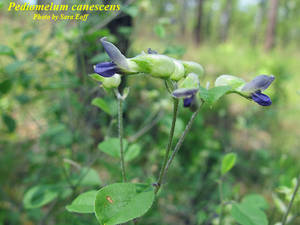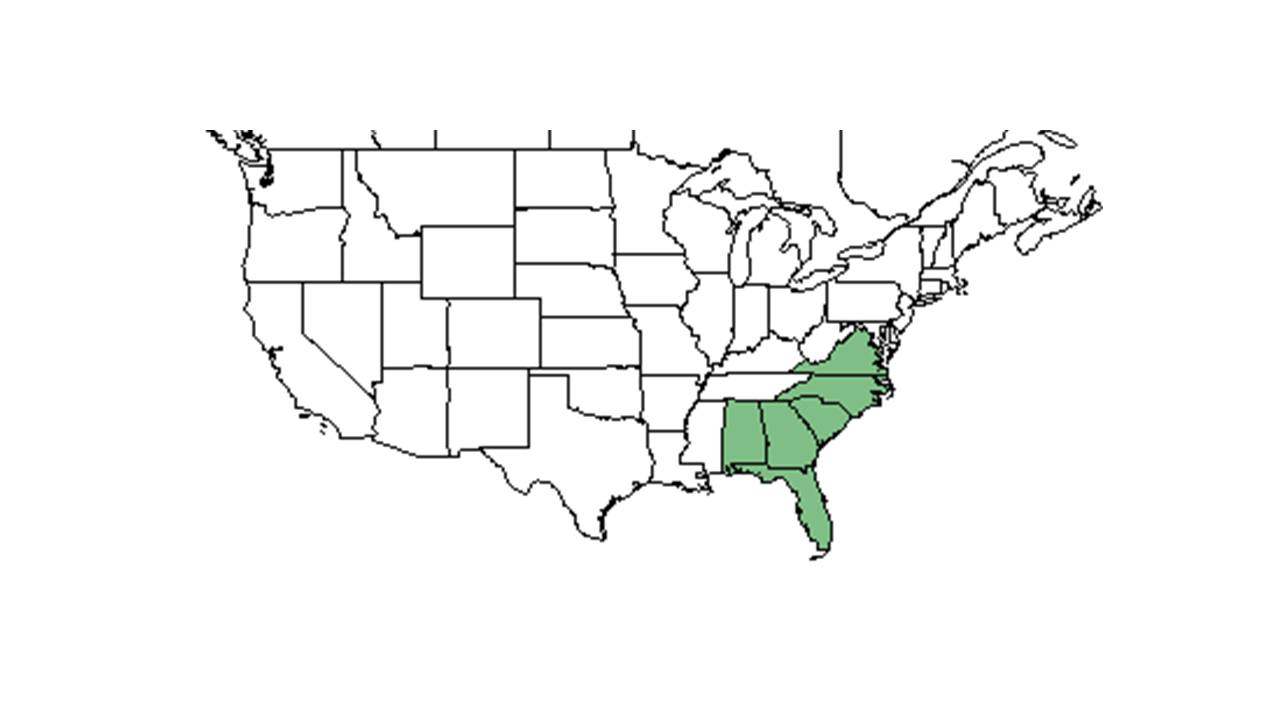Difference between revisions of "Pediomelum canescens"
(→Description) |
|||
| Line 32: | Line 32: | ||
==Ecology== | ==Ecology== | ||
===Habitat=== <!--Natural communities, human disturbed habitats, topography, hydrology, soils, light, fire regime requirements for removal of competition, etc.--> | ===Habitat=== <!--Natural communities, human disturbed habitats, topography, hydrology, soils, light, fire regime requirements for removal of competition, etc.--> | ||
| − | ''P. canescens'' occurs in sandy areas of the Coastal Plain | + | ''P. canescens'' occurs in sandy areas of the Coastal Plain <ref name=gra/> such as longleaf pine-turkey oak sand ridge, secondary longleaf pine-turkey oak sand-hill ridge, longleaf pine-wiregrass sandridge, pine flatwoods, and open sandridges (FSU Herbarium). Has been observed growing on drying sand besides roads in open pine-oak woodlands and dry sandy fields (FSU Herbarium). Associated species include ''Serenoa repens, Quercus incana, Quercus chapmanii, Quercus laevis, Aristida, Andropogon, Onosmodium'', bahia grass, and ''Diospyros'' (FSU Herbarium). |
===Phenology=== <!--Timing off flowering, fruiting, seed dispersal, and environmental triggers. Cite PanFlora website if appropriate: http://www.gilnelson.com/PanFlora/ --> | ===Phenology=== <!--Timing off flowering, fruiting, seed dispersal, and environmental triggers. Cite PanFlora website if appropriate: http://www.gilnelson.com/PanFlora/ --> | ||
Revision as of 20:00, 12 April 2016
| Pediomelum canescens | |
|---|---|

| |
| Photo by Sara Eoff, Atlas of Florida Vascular Plants | |
| Scientific classification | |
| Kingdom: | Plantae |
| Division: | Magnoliophyta - Flowering plants |
| Class: | Magnoliopsida – Dicotyledons |
| Order: | Fabales |
| Family: | Fabaceae ⁄ Leguminosae |
| Genus: | Pediomelum |
| Species: | P. canescens |
| Binomial name | |
| Pediomelum canescens (Michx.) Rydb. | |

| |
| Natural range of Pediomelum canescens from USDA NRCS Plants Database. | |
Common name: buckroot
Contents
Taxonomic notes
Synonym: Psoralea canescens Michx.
Description
Pediomelum canescens is a perennial herbaceous species with a bushy growth habit (FSU Herbarium) it grows 1 to 3 feet tall with loose spike of dark-blue flowers and 1 to 3 foliolate leaves. [1]
"Perennial herbs, subshrubs or shrubs, more or less postulate-glandular. Leaves odd-pinnate or palmate, (1) 3-5 (7) foliolate, stipules usually persistent. Racemes or spikes pedunculate, axillary and sometimes also terminal; flowers papilionaceous. Calyx persistent, the lowermost lobe the longest or rarely all nearly equal; petals 5, blue-purple or rarely white; stamens 10, rarely 9, diadelphous or weakly monadelphous; ovary sessile or stipitate, usually 1-ovuled. Legume usually not much longer than the calyx, often conspicuously wrinkled, indehiscent or irregularly dehiscent, 1-seeded." - Radford et al 1964
"Coarsely canescent, perennial herb, 3-10 dm tall, from a subglobose or fusiform root 2.-4 cm thick. Leaves palmately 3-foliolate or the uppermost sometimes 1-foliolate; leaflets elliptic to obovate, mostly 1.5-6 cm long, 1-3 cm wide, eglandular to abundantly but inconspicuously glandular-punctate on both surfaces. Racemes loosely few-flowered, 2-6 cm long; peduncles 2-7 cm long, pedicels 3-6 mm long, each subtended by an ovate bract 4-6 mm long. Calyx appressed to spreading villous; petals blue or violet, 8-15 mm long. Legume ovoid, ca. 1 cm long, dehiscent." - Radford et al 1964
Distribution
Ecology
Habitat
P. canescens occurs in sandy areas of the Coastal Plain [1] such as longleaf pine-turkey oak sand ridge, secondary longleaf pine-turkey oak sand-hill ridge, longleaf pine-wiregrass sandridge, pine flatwoods, and open sandridges (FSU Herbarium). Has been observed growing on drying sand besides roads in open pine-oak woodlands and dry sandy fields (FSU Herbarium). Associated species include Serenoa repens, Quercus incana, Quercus chapmanii, Quercus laevis, Aristida, Andropogon, Onosmodium, bahia grass, and Diospyros (FSU Herbarium).
Phenology
Observed blooming May through October (FSU Herbarium).
Seed dispersal
According to Kay Kirkman, a plant ecologist, this species disperses by gravity. [2]
Use by animals
Seeds have been found in bobwhite stomachs (Graham 1941).
Conservation and Management
Cultivation and restoration
Photo Gallery
References and notes
Florida State University Robert K. Godfrey Herbarium database. URL: http://herbarium.bio.fsu.edu. Last accessed: June 2014. Collectors: Robert Kral, Mabel Kral, O. Lakela, R.K. Godfrey, H. R. Reed, Loran C. Anderson, T. MacClendon, K. MacClendon, Cecil Slaughter, Travis Richardson, Steve L. Orzell, E. L. Bridges, A. F. Clewell, Sidney McDaniel, Raymond Athey, Richard D. Houk, Raymond Athey, R. A. Norris, R. Komarek, H. E. Ahles, J. Haesloop, J. R. Burkhalter, LK Kirkman, A. Gholson, D. Wolfe, Annie Schmidt, A. Johnson, and M. Jenkins. States and Counties: Florida: Bay, Calhoun, Citrus, Clay, Dixie, Duval, Escambia, Franklin, Gadsden, Hamilton, Hernando, Highlands, Hillsborough, Jackson, Leon, Madison, Okaloosa, Santa Rosa, Suwannee, Taylor, Wakulla, Walton, and Washington. Georgia: Baker, Lowndes, and Thomas. North Carolina: Hoke. Alabama: Baldwin, Geneva, and Henry.
Graham, E. H. (1941). Legumes for erosion control and wildlife. Washington, USDA
Radford, Albert E., Harry E. Ahles, and C. Ritchie Bell. Manual of the Vascular Flora of the Carolinas. 1964, 1968. The University of North Carolina Press. 599-601. Print.